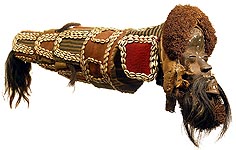WE / WOBE MASKS ARCHIVES, Liberia
The masks below have been sold and are left here for reference and educational
purposes.
For UNSOLD We/Wobe masks GO TO WE/WOBE MASK 251
Photographs © Hamill Gallery
WE, WOBE MASKS, Liberia
Living in along the western edge of the Ivory Coast, the Wobe and their
neighbors the Guere share numerous customs and beliefs. Although they are
separate tribes, the two peoples are often referred to as the We, whose
name means "men who easily forgive
According to Jean-Baptiste Bacquart in his excellent book The Tribal
Arts of Africa, We carvers focused on sculpting powerful face masks
to which paraphernalia such as shells, bells, nails and feathers were added
which were thought to reinforce the power of the masks.
The ferocious aspect of We/Guere masks - bulging eyes, open mouths and sometimes
protruding horns - accounts for their identification as "war"
masks but, according to Bacquart, they are worn primarily during funerals
and - in a"detective" capacity - to single out guilty persons.
We carvers seem to have focused their skills on carving powerful face
masks to which paraphernalia such as cowrie shells, bells, nails and feathers
were attached. These applied pieces were thought to reinforce the power
of the mask. Wobe masks have protruding globular eyes and enlarged lips.
The horns found on Guere masks are usually absent from Wobe ones.
-----From The Tribal Arts of Africa by Jean-Baptiste Bacquart.
GO TO WE/WOBE MASK 251 PAGE
RETURN TO DAN ART PAGE
GO TO MASKS OF
THE DAN EXHIBITION PAGE
GO TO BASSA
MASKS PAGE
GO TO DAN MASKS PAGE
GO TO DAN
GAGON MASKS PAGE
GO TO DAN MAOU
MASKS PAGE
GO TO WE / GUERE MASKS
PAGE
GO TO DAN MASKS
3 PAGE
GO TO DAN
METAL MASKS PAGE
GO
TO DAN MASKS AND HEADDRESSES PAGE
GO TO TOMA MASKS
PAGE
GO TO AFRICAN MASKS PAGE
GO TO NEW ADDITIONS PAGE












